20 false Islamic inventions
 Bashny.Net
Bashny.Net
INTRODUCTION
The last few years we have seen many inventions, falsely attributed to Islamic inventors who, in fact, ever existed before Islam or were created by other cultures. Such statements are imposed, the unsuspecting public at the state level, at the opening of the exhibition at the Museum of Science and Industry in Manchester at Manchester University in England. To celebrate this "important" event, the British journalist Paul Vallely wrote an article titled "How Islamic inventors changed the world", which was published in «The Independent», March 11, 2006. This shameless propaganda sample received a lot of praise from Muslims and is still widely advertised on Islamic websites, forums, blogs, and even used as a source for the 20 articles in Wikipedia. [1]
Vallely article begins with the following bold statement: "From coffee to checks and the three-course meal - the Muslim world has given us many innovations that we take for granted in everyday life. By the opening of a new exhibition, I declare the 20 most significant inventions and disclose geniuses behind them. "[2]
The purpose of this article - to expose the lies of these 20 "Islamic" inventions.
We have contacts to Paul Vallely and gave him a refutation of his article, but the answer from him so far not received.
Invention
Coffee
Photo camera
Chess
Aeronautics
Bathing and soap
Distillation
Crank shaft
Quilted fabric
Architecture
Medical instruments
Windmill
Vaccinations
Pen
Figures
A three-course meal
Carpets
Modern checks
Round Earth
Gunpowder
Gardens
1. COFFEE
The story goes that an Arab named Khalid pass his goats in the Kaffa region in southern Ethiopia, when he noticed that his animals came to life after eating certain berries. He boiled the berries and made the first coffee. The first mention of the drink is associated with beans imported from Ethiopia to Yemen where Sufis drank it, to stay up all night to pray on special occasions. By the end of the 15th century learned about coffee in Mecca and Turkey, where in 1645 he was in Venice. In 1650, coffee was brought to England a Turk named Pasqua Rosii, who opened the first coffee shop in Lombard Street in the City of London. Arabic "kava" became the Turkish "kava", then the Italian "cafe" and English "Kofi". [2]
From an article by Paul Vallely "How Islamic inventors changed the world»
Legend referenced by Paul Vallely, set out in the history of coffee, the site Decent Coffee: «Arab kofepitiya began almost 12 centuries ago (850), when Khalid Abyssinian goat herder noticed that, at the time, as it tended to sleep at sunset, the whole flock of frolicking, eating what that berries. Khalid, or ate the berries raw, whether before, cook them. When his wife saw vigorous Khalid instead, usually tired she told him to tell the miraculous discovery of local saints in the monastery. However, the head monk did not share the enthusiasm of Khalid. Declaring berries "devil's work", he threw them into the fire. Soon the room was filled with a delicious aroma of roasted berries and other monks were quick to identify the source of this pleasure. »
Please note that the shepherd Khalid (arabiziroannaya version, according to another version of his name - Caldey) was Abyssinian. Abyssinians (Ethiopians) were and are predominantly Orthodox Christians. In addition to this, in Islam there is no monasteries and monks or, as it is forbidden (Sura 57: 027). Therefore, if the legend is true, Khalid (Kaldi) was not a Muslim and a Christian.
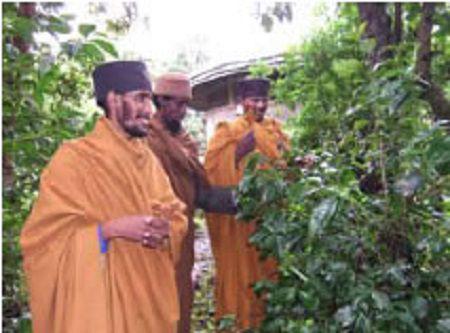
Christian monks in the monastery on the island of Dag Estefanos in Ethiopia
and today produce and sell coffee under the brand name "Coffee Monastery Lake Tana».
History of the discovery of coffee, according to the Maronite monk Antony Nayronusu Faust (1635 - 1707), differs slightly from the above shown legend. In his work «De saluberrima potione Cahue, seu Cafe nuncupata discursus» (1671), he writes that the shepherd complained to the abbot of the nearby monastery in Abyssinia that his animals can not fall asleep. Head of the monastery sent together with the shepherd two monks that they found that the animals ate. Monks discovered coffee plant, which have brought to the monastery where they cooked drink from its fruits. Then they spent the whole night in pleasant conversation without feeling tired. This evidence, no doubt, shows that Christian monks began to cultivate coffee plants and make a drink from the deification of coffee beans. [3]

2. PHOTO CAMERA
The ancient Greeks thought our eyes emitted rays, like a laser, and it allows us to see. The first to realize that light enters the eye, rather than out of it, was a Muslim mathematician, astronomer and physicist of the 10th century, Ibn al-Haytham. He invented the first hole camera to see how the light penetrates through the hole in the shutters. The smaller the hole, the better the picture; he created the first camera obscura (from the Arabic word «qamara» dark or private room). He is also credited with the transfer of physics from a philosophical activity to an experimental. [2]
From an article by Paul Vallely "How Islamic inventors changed the world»
Basic optical principles of the camera obscura explained in Chinese texts from the 5th century BC. Perhaps Ibn al-Haytham was the first to realize that light enters the eye, but the claim that he invented the camera hole is a lie.
For a long time the inventor of the camera obscura was considered a scholar of Naples, Giovanni Battista della Porta (1538 - 1615), as a description of the camera is in its «Magia Naturalis» (1558). However, the first published image of the camera hole is in the works «Gemma Frisius' De Radio Astronomica et Geometrica» (1545). [4]
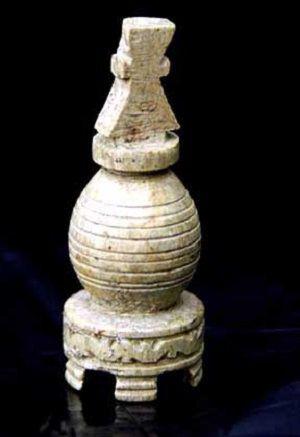
The first image of the hole camera. Illustration of work «De Radio Astronomica et Geometrica» (1545).
Although both languages, and Latin, and Arabic - borrowed from each other, the Latin language over classical Arabic (the predecessor of the modern Arabic), at least 1,600 years. The word "camera" is not derived from the Arabic word «qamara». "Camera" - the Latin word for a vaulted or arched space, it derives from the Greek word "Camara," which refers to the fact that it has an arched roof. The Italian word «camera», the French word «chambre» English word «chamber» - they all have a Latin root. "Camera Obscura" literally "dark room." [5] [6] The term "cell" as used today, was first coined by Johannes Kepler (1571-1630). The Arabic word «qamara», almost certainly, was borrowed from the Latin word "camera". [4]
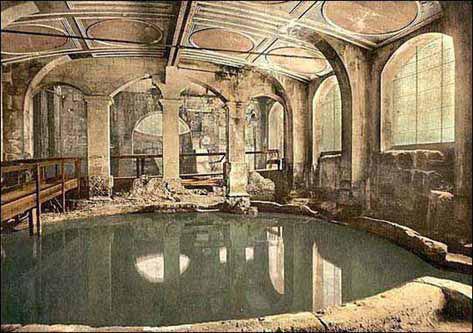
3. CHESS
In some kind of chess played in ancient India, but chess, in the form in which we know them today were established in Persia. From there they came to the west in Europe, where they were put into circulation by the Moors in Spain in the 10th century, and to the east to Japan. The word rook (rook) comes from the Persian «rukh», which means chariot. [2]
From an article by Paul Vallely "How Islamic inventors changed the world»

Fragment of a chess piece 6th century found in Butrint, Albania.
British archaeologists, in July 2002, found fragments of chess pieces of ivory in the Byzantine palace in southern Albania, proving that Europeans were playing chess much earlier than previously thought. This discovery, which dates back to the 6th century (that is 500 years older than any known) does not allow Muslims to claim that they belong to the brains of idiots who introduced the West to chess, after 400 years (10th century) through Spain. [7] And, although the form of chess, which we know today, was largely (though not completely), developed in Persia, it was the Persians, Zoroastrians (and non-Muslims), who lived up to the Arab-Islamic nashestviya.Takzhe , looks ironic fact that chess is prohibited in Islam because they personally condemned Muhammad, who compared the chess player with who covered his hands with the flesh and blood of a pig. [8] [9] Thus, Paul Vallely, and those Muslims who claim that Islam was the source of the spread of chess in Europe, on the one hand, makes a false scientific statement, but On the other - insult the piety of Islam and Muhammad, who heard them probably turning in his grave.
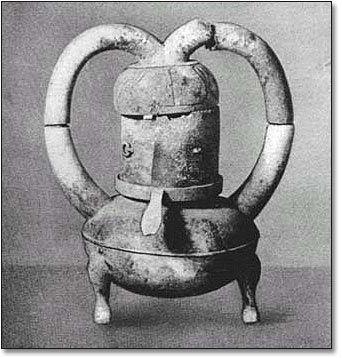
4. aeronautics
A thousand years before the Wright brothers a Muslim poet, astronomer, musician and engineer Abbas Ibn Firnas made several attempts to build a flying machine. In 852, he jumped from the minaret of a mosque in Cordoba using uncool robe fastened by wooden struts. He had hoped to plan like a bird. But it did not happen. But the cloak slowed his fall, creating what is considered the first parachute, Firnas escaped with minor injuries. In 875, at the age of 70 years, perfecting his apparatus, made of silk and feathers of an eagle, he tried again, jumping from a mountain. He rose to a considerable height and stayed aloft for ten minutes but crashed on landing because his device was not tail to stabilize the land. It is named after the international airport in Baghdad and a crater on the moon. [2]
From an article by Paul Vallely "How Islamic inventors changed the world»
To get to the root of the fact of who was the first balloonist, you need to refer to the earlier history. The first aircraft is a Chinese invention - a kite. Its age is about 3,000 years old, they were made in China from bamboo and silk. The earliest written mention of kites date back to 200 BC In the year 478 BC Chinese philosopher Mo Tzu, spent three years to build a hawk from a light wood or bamboo, which floated in the wind. The unit flew, but one day, after the test, it was destroyed. Kites, too, have long been used by the Chinese in the wars. There have been many attempts at human flight using kites, written sources tell of many deaths.
In 550 AD, Emperor Kao Yang defeated his powerful enemies - Topa family and Yuan. He ordered the prisoners to put on Top and Yuan wings of bamboo mats and push them to the top of the tower of the Golden Phoenix. All were killed. Other prisoners attached to kites and collided with the tower. Only one of the prisoners survived the flight over a distance of 2, 5 kilometers.
The Chinese, too, have tried to produce and flying machines. Koh Hong, in his book "Pao Fu Zi" (320 AD), writes: "Some have done flying machines made of wood, using a shaft with leather straps, which carries the rotating blades to bring the machine in motion».
He clearly describes the rotating blades attached to a rotating axis controlled (leather) belt, which is an upper rotor - a prototype of the main elements of a modern helicopter. It seems that the system worked because the flying machine was used. The machine, known as "bamboo dragonfly" is still used today as a children's toy. [10] [11] [12]
Ancient Greek engineer Hero of Alexandria, worked with the pressure of air and steam as sources of energy. One mechanism for its development was Aeolipil who used a jet of steam to generate a rotational movement. Aeolipila importance that it marks the beginning of the creation of the engine, the movement created by the machine (not muscle), which later will be significant in the history of aeronautics. [13]
Given the above information, whether it is possible to attribute the discovery of aeronautics Muslim who in the 9th century, jumped from a mosque in Spain?
5. bathing and soap
Washing and bathing are religious requirements for Muslims, which is perhaps why perfected recipe soap which we still use today. The ancient Egyptians were, its kind of soap, like the Romans, who used it more as a pomade. But the Arabs have combined vegetable oils with sodium hydroxide and aromatics such as thyme oil. England acquainted with shampoo Muslim who opened the Mohammedans-Indiyskkuyu steam room on the seafront of Brighton, in 1759 and was appointed physician to King George IV and William IV. [2]
From an article by Paul Vallely "How Islamic inventors changed the world»
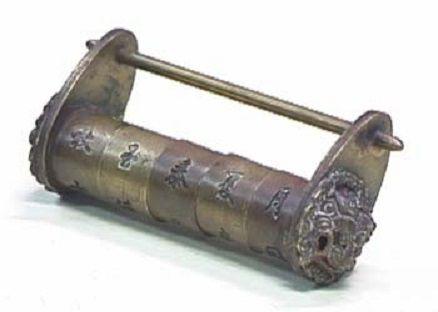
Above: partial restoration of Trajan's Baths (98 - 117 years BC) in Rome.
Below: The Restoration of a Roman bath in London.
The first question we must decide is whether the "Muslim" one of whom says Paul Vallely. His name was Sek Din Muhammad and he was not a Muslim but converted to Christianity. [14] He was born to Muslim parents in 1759, and then converted to Christianity and married the Anglo-Irish noblewoman Jane Daly at the Anglican rite in 1786 [15] (long before he discovered the "Indian Muslims steam bath" in 1821 ). [16] Two of his children (Amelia and Henry) were also baptized in the Anglican faith. Also noteworthy fact that not only Islam dictates the rules of personal hygiene. The Jews also have rules governing gigienu.Mylopodobnye materials were found in clay cylinders during the excavation of ancient Babylon, indicating that the soap-making has been known for 2,800 years BC. e. Inscriptions on the cylinders say that fat is boiled with ash, which is a method of making soap, but not in order to get specific "soap". Such materials were later used as a means for laying volos.U ancient Romans, like the ancient Egyptians, the daily bath was an important event [17], bathing was the general rule in medieval Japan. And in Iceland, pools, heated water from the hot springs were popular gathering places on Saturday nights.
Soap was one of the main crafts in Europe as early as the 7th century. Soap guild strictly kept their production recipes. Used for soap making plant and animal oils, together with ashes of plants, with the addition of flavorings.
Gradually appears more and more diverse varieties, such as shaving soap, shampoo and soap for bathing and washing. The British began to produce soap in the 12th century. Trade soap was so good that in 1622, King James I granted a monopoly on the production of soap for 100,000 pounds a year. Science of modern production of soap was born in 1820 with the opening of the French chemist Michel Eugène Chevrel, chemical nature and proportions of fats, glycerol and fatty acids. His research laid the foundation giro and soap chemistry. [19] Who, then, can claim that Muslims invented soap and that England was dirty, before the Muslims have decorated it with their presence.
(It should be added that no ritual hygiene, no baths are not the invention of the Arabs or Muslims. Ritual hygiene, in simplified form, the founder of Islam borrowed from the Jews. The magnificent beauty and engineering bath with steam-heated floor and van were built by the Greeks, Romans and Byzantines in all areas of the Hellenistic world, long before the advent of Islam, these baths and surprise the audience today at archaeological sites in Italy, Greece, Syria, Israel and the former Byzantine Empire. In addition, excavated Hellenistic cities, too, can see the public toilets, with constant washing with water that perfectly meet the requirements of modern hygiene [translator's note].)

6. DISTILLATION
Method of separating liquids through differences in their boiling points was invented approximately in the year 800, an Islamic scholar Jabir Ibn Haiyan, who transformed alchemy into chemistry, revealing many of the basic processes and apparatus used to this day, such as: liquefaction, crystallisation, distillation, purification, oxidation, evaporation and filtration. He also opened the sulfuric and nitric acids, invented the alembic, gave the world an extract of rose water and other perfumes. Ibn Hayan emphasized the systematic experimentation and was the founder of modern chemistry. [2]
From an article by Paul Vallely "How Islamic inventors changed the world»
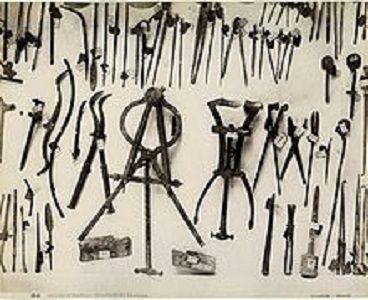
Apparatus for distillation period the Chinese Han Dynasty, around the first century AD. [18]
Speculation Paul Vallely is associated with some Egyptian illustrations of distillation, but the earliest evidence of this invention, so far, is considered: a distillation apparatus and terracotta container of spirits found in the Indus Valley (in what is now Pakistan), which date from about 3000 a year BC The first documentary evidence of the distillation process in Europe belongs to the Greek historian Herodotus, who described the method of distillation as early as 425 BC [21] In addition, the creation of the drink, whiskey, dates back to the 5th century AD, had brought into Ireland Saint Patrick (390 - 461 AD.), the patron of the Irish. [22] Thus, the Arabs could just deal with the improvement of the distillation process after 3500 years after this process was invented, and then widely used in Europe and Azii.Krome, it should be noted that the author of many books written in the beginning of 1300,
BC
--img16--
--img18--
--img19--
--img20--
--img21--
--img22--
In conclusion.
--img24--
--img25--
--img26--
--img27--
--img28--
--img29--
The last few years we have seen many inventions, falsely attributed to Islamic inventors who, in fact, ever existed before Islam or were created by other cultures. Such statements are imposed, the unsuspecting public at the state level, at the opening of the exhibition at the Museum of Science and Industry in Manchester at Manchester University in England. To celebrate this "important" event, the British journalist Paul Vallely wrote an article titled "How Islamic inventors changed the world", which was published in «The Independent», March 11, 2006. This shameless propaganda sample received a lot of praise from Muslims and is still widely advertised on Islamic websites, forums, blogs, and even used as a source for the 20 articles in Wikipedia. [1]
Vallely article begins with the following bold statement: "From coffee to checks and the three-course meal - the Muslim world has given us many innovations that we take for granted in everyday life. By the opening of a new exhibition, I declare the 20 most significant inventions and disclose geniuses behind them. "[2]
The purpose of this article - to expose the lies of these 20 "Islamic" inventions.
We have contacts to Paul Vallely and gave him a refutation of his article, but the answer from him so far not received.
Invention
Coffee
Photo camera
Chess
Aeronautics
Bathing and soap
Distillation
Crank shaft
Quilted fabric
Architecture
Medical instruments
Windmill
Vaccinations
Pen
Figures
A three-course meal
Carpets
Modern checks
Round Earth
Gunpowder
Gardens
1. COFFEE
The story goes that an Arab named Khalid pass his goats in the Kaffa region in southern Ethiopia, when he noticed that his animals came to life after eating certain berries. He boiled the berries and made the first coffee. The first mention of the drink is associated with beans imported from Ethiopia to Yemen where Sufis drank it, to stay up all night to pray on special occasions. By the end of the 15th century learned about coffee in Mecca and Turkey, where in 1645 he was in Venice. In 1650, coffee was brought to England a Turk named Pasqua Rosii, who opened the first coffee shop in Lombard Street in the City of London. Arabic "kava" became the Turkish "kava", then the Italian "cafe" and English "Kofi". [2]
From an article by Paul Vallely "How Islamic inventors changed the world»
Legend referenced by Paul Vallely, set out in the history of coffee, the site Decent Coffee: «Arab kofepitiya began almost 12 centuries ago (850), when Khalid Abyssinian goat herder noticed that, at the time, as it tended to sleep at sunset, the whole flock of frolicking, eating what that berries. Khalid, or ate the berries raw, whether before, cook them. When his wife saw vigorous Khalid instead, usually tired she told him to tell the miraculous discovery of local saints in the monastery. However, the head monk did not share the enthusiasm of Khalid. Declaring berries "devil's work", he threw them into the fire. Soon the room was filled with a delicious aroma of roasted berries and other monks were quick to identify the source of this pleasure. »
Please note that the shepherd Khalid (arabiziroannaya version, according to another version of his name - Caldey) was Abyssinian. Abyssinians (Ethiopians) were and are predominantly Orthodox Christians. In addition to this, in Islam there is no monasteries and monks or, as it is forbidden (Sura 57: 027). Therefore, if the legend is true, Khalid (Kaldi) was not a Muslim and a Christian.

Christian monks in the monastery on the island of Dag Estefanos in Ethiopia
and today produce and sell coffee under the brand name "Coffee Monastery Lake Tana».
History of the discovery of coffee, according to the Maronite monk Antony Nayronusu Faust (1635 - 1707), differs slightly from the above shown legend. In his work «De saluberrima potione Cahue, seu Cafe nuncupata discursus» (1671), he writes that the shepherd complained to the abbot of the nearby monastery in Abyssinia that his animals can not fall asleep. Head of the monastery sent together with the shepherd two monks that they found that the animals ate. Monks discovered coffee plant, which have brought to the monastery where they cooked drink from its fruits. Then they spent the whole night in pleasant conversation without feeling tired. This evidence, no doubt, shows that Christian monks began to cultivate coffee plants and make a drink from the deification of coffee beans. [3]

2. PHOTO CAMERA
The ancient Greeks thought our eyes emitted rays, like a laser, and it allows us to see. The first to realize that light enters the eye, rather than out of it, was a Muslim mathematician, astronomer and physicist of the 10th century, Ibn al-Haytham. He invented the first hole camera to see how the light penetrates through the hole in the shutters. The smaller the hole, the better the picture; he created the first camera obscura (from the Arabic word «qamara» dark or private room). He is also credited with the transfer of physics from a philosophical activity to an experimental. [2]
From an article by Paul Vallely "How Islamic inventors changed the world»
Basic optical principles of the camera obscura explained in Chinese texts from the 5th century BC. Perhaps Ibn al-Haytham was the first to realize that light enters the eye, but the claim that he invented the camera hole is a lie.
For a long time the inventor of the camera obscura was considered a scholar of Naples, Giovanni Battista della Porta (1538 - 1615), as a description of the camera is in its «Magia Naturalis» (1558). However, the first published image of the camera hole is in the works «Gemma Frisius' De Radio Astronomica et Geometrica» (1545). [4]

The first image of the hole camera. Illustration of work «De Radio Astronomica et Geometrica» (1545).
Although both languages, and Latin, and Arabic - borrowed from each other, the Latin language over classical Arabic (the predecessor of the modern Arabic), at least 1,600 years. The word "camera" is not derived from the Arabic word «qamara». "Camera" - the Latin word for a vaulted or arched space, it derives from the Greek word "Camara," which refers to the fact that it has an arched roof. The Italian word «camera», the French word «chambre» English word «chamber» - they all have a Latin root. "Camera Obscura" literally "dark room." [5] [6] The term "cell" as used today, was first coined by Johannes Kepler (1571-1630). The Arabic word «qamara», almost certainly, was borrowed from the Latin word "camera". [4]

3. CHESS
In some kind of chess played in ancient India, but chess, in the form in which we know them today were established in Persia. From there they came to the west in Europe, where they were put into circulation by the Moors in Spain in the 10th century, and to the east to Japan. The word rook (rook) comes from the Persian «rukh», which means chariot. [2]
From an article by Paul Vallely "How Islamic inventors changed the world»

Fragment of a chess piece 6th century found in Butrint, Albania.
British archaeologists, in July 2002, found fragments of chess pieces of ivory in the Byzantine palace in southern Albania, proving that Europeans were playing chess much earlier than previously thought. This discovery, which dates back to the 6th century (that is 500 years older than any known) does not allow Muslims to claim that they belong to the brains of idiots who introduced the West to chess, after 400 years (10th century) through Spain. [7] And, although the form of chess, which we know today, was largely (though not completely), developed in Persia, it was the Persians, Zoroastrians (and non-Muslims), who lived up to the Arab-Islamic nashestviya.Takzhe , looks ironic fact that chess is prohibited in Islam because they personally condemned Muhammad, who compared the chess player with who covered his hands with the flesh and blood of a pig. [8] [9] Thus, Paul Vallely, and those Muslims who claim that Islam was the source of the spread of chess in Europe, on the one hand, makes a false scientific statement, but On the other - insult the piety of Islam and Muhammad, who heard them probably turning in his grave.

4. aeronautics
A thousand years before the Wright brothers a Muslim poet, astronomer, musician and engineer Abbas Ibn Firnas made several attempts to build a flying machine. In 852, he jumped from the minaret of a mosque in Cordoba using uncool robe fastened by wooden struts. He had hoped to plan like a bird. But it did not happen. But the cloak slowed his fall, creating what is considered the first parachute, Firnas escaped with minor injuries. In 875, at the age of 70 years, perfecting his apparatus, made of silk and feathers of an eagle, he tried again, jumping from a mountain. He rose to a considerable height and stayed aloft for ten minutes but crashed on landing because his device was not tail to stabilize the land. It is named after the international airport in Baghdad and a crater on the moon. [2]
From an article by Paul Vallely "How Islamic inventors changed the world»
To get to the root of the fact of who was the first balloonist, you need to refer to the earlier history. The first aircraft is a Chinese invention - a kite. Its age is about 3,000 years old, they were made in China from bamboo and silk. The earliest written mention of kites date back to 200 BC In the year 478 BC Chinese philosopher Mo Tzu, spent three years to build a hawk from a light wood or bamboo, which floated in the wind. The unit flew, but one day, after the test, it was destroyed. Kites, too, have long been used by the Chinese in the wars. There have been many attempts at human flight using kites, written sources tell of many deaths.
In 550 AD, Emperor Kao Yang defeated his powerful enemies - Topa family and Yuan. He ordered the prisoners to put on Top and Yuan wings of bamboo mats and push them to the top of the tower of the Golden Phoenix. All were killed. Other prisoners attached to kites and collided with the tower. Only one of the prisoners survived the flight over a distance of 2, 5 kilometers.
The Chinese, too, have tried to produce and flying machines. Koh Hong, in his book "Pao Fu Zi" (320 AD), writes: "Some have done flying machines made of wood, using a shaft with leather straps, which carries the rotating blades to bring the machine in motion».
He clearly describes the rotating blades attached to a rotating axis controlled (leather) belt, which is an upper rotor - a prototype of the main elements of a modern helicopter. It seems that the system worked because the flying machine was used. The machine, known as "bamboo dragonfly" is still used today as a children's toy. [10] [11] [12]
Ancient Greek engineer Hero of Alexandria, worked with the pressure of air and steam as sources of energy. One mechanism for its development was Aeolipil who used a jet of steam to generate a rotational movement. Aeolipila importance that it marks the beginning of the creation of the engine, the movement created by the machine (not muscle), which later will be significant in the history of aeronautics. [13]
Given the above information, whether it is possible to attribute the discovery of aeronautics Muslim who in the 9th century, jumped from a mosque in Spain?
5. bathing and soap
Washing and bathing are religious requirements for Muslims, which is perhaps why perfected recipe soap which we still use today. The ancient Egyptians were, its kind of soap, like the Romans, who used it more as a pomade. But the Arabs have combined vegetable oils with sodium hydroxide and aromatics such as thyme oil. England acquainted with shampoo Muslim who opened the Mohammedans-Indiyskkuyu steam room on the seafront of Brighton, in 1759 and was appointed physician to King George IV and William IV. [2]
From an article by Paul Vallely "How Islamic inventors changed the world»

Above: partial restoration of Trajan's Baths (98 - 117 years BC) in Rome.
Below: The Restoration of a Roman bath in London.
The first question we must decide is whether the "Muslim" one of whom says Paul Vallely. His name was Sek Din Muhammad and he was not a Muslim but converted to Christianity. [14] He was born to Muslim parents in 1759, and then converted to Christianity and married the Anglo-Irish noblewoman Jane Daly at the Anglican rite in 1786 [15] (long before he discovered the "Indian Muslims steam bath" in 1821 ). [16] Two of his children (Amelia and Henry) were also baptized in the Anglican faith. Also noteworthy fact that not only Islam dictates the rules of personal hygiene. The Jews also have rules governing gigienu.Mylopodobnye materials were found in clay cylinders during the excavation of ancient Babylon, indicating that the soap-making has been known for 2,800 years BC. e. Inscriptions on the cylinders say that fat is boiled with ash, which is a method of making soap, but not in order to get specific "soap". Such materials were later used as a means for laying volos.U ancient Romans, like the ancient Egyptians, the daily bath was an important event [17], bathing was the general rule in medieval Japan. And in Iceland, pools, heated water from the hot springs were popular gathering places on Saturday nights.
Soap was one of the main crafts in Europe as early as the 7th century. Soap guild strictly kept their production recipes. Used for soap making plant and animal oils, together with ashes of plants, with the addition of flavorings.
Gradually appears more and more diverse varieties, such as shaving soap, shampoo and soap for bathing and washing. The British began to produce soap in the 12th century. Trade soap was so good that in 1622, King James I granted a monopoly on the production of soap for 100,000 pounds a year. Science of modern production of soap was born in 1820 with the opening of the French chemist Michel Eugène Chevrel, chemical nature and proportions of fats, glycerol and fatty acids. His research laid the foundation giro and soap chemistry. [19] Who, then, can claim that Muslims invented soap and that England was dirty, before the Muslims have decorated it with their presence.
(It should be added that no ritual hygiene, no baths are not the invention of the Arabs or Muslims. Ritual hygiene, in simplified form, the founder of Islam borrowed from the Jews. The magnificent beauty and engineering bath with steam-heated floor and van were built by the Greeks, Romans and Byzantines in all areas of the Hellenistic world, long before the advent of Islam, these baths and surprise the audience today at archaeological sites in Italy, Greece, Syria, Israel and the former Byzantine Empire. In addition, excavated Hellenistic cities, too, can see the public toilets, with constant washing with water that perfectly meet the requirements of modern hygiene [translator's note].)

6. DISTILLATION
Method of separating liquids through differences in their boiling points was invented approximately in the year 800, an Islamic scholar Jabir Ibn Haiyan, who transformed alchemy into chemistry, revealing many of the basic processes and apparatus used to this day, such as: liquefaction, crystallisation, distillation, purification, oxidation, evaporation and filtration. He also opened the sulfuric and nitric acids, invented the alembic, gave the world an extract of rose water and other perfumes. Ibn Hayan emphasized the systematic experimentation and was the founder of modern chemistry. [2]
From an article by Paul Vallely "How Islamic inventors changed the world»

Apparatus for distillation period the Chinese Han Dynasty, around the first century AD. [18]
Speculation Paul Vallely is associated with some Egyptian illustrations of distillation, but the earliest evidence of this invention, so far, is considered: a distillation apparatus and terracotta container of spirits found in the Indus Valley (in what is now Pakistan), which date from about 3000 a year BC The first documentary evidence of the distillation process in Europe belongs to the Greek historian Herodotus, who described the method of distillation as early as 425 BC [21] In addition, the creation of the drink, whiskey, dates back to the 5th century AD, had brought into Ireland Saint Patrick (390 - 461 AD.), the patron of the Irish. [22] Thus, the Arabs could just deal with the improvement of the distillation process after 3500 years after this process was invented, and then widely used in Europe and Azii.Krome, it should be noted that the author of many books written in the beginning of 1300,
BC
--img16--
--img18--
--img19--
--img20--
--img21--
--img22--
In conclusion.
--img24--
--img25--
--img26--
--img27--
--img28--
--img29--
Tags
See also
The most influential books of the twentieth century
The biggest stadium in the world
Inventions Nikola Tesla. Mysteries and Myths
The invention does not require completion
Ancient optical lenses for more than a century was not noticed by the archaeologists!
Lying Lie Detector
In the 18th century, it was invented by "safe" coffin
Modern inventions from the past (10 pictures)

















